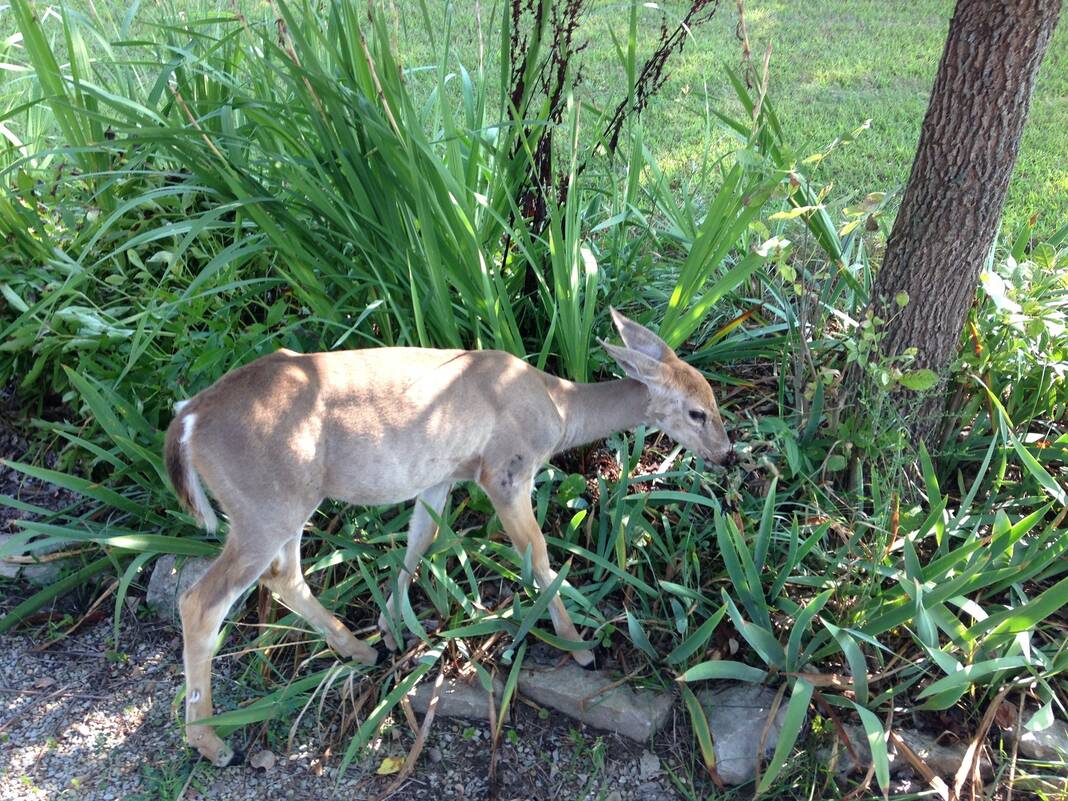
A hungry deer grazing in a garden.
Photo courtesy of MelindaMyers.com
by Melinda Myers
Deer are common visitors to landscapes even in urban and suburban areas. Fencing is the most effective way to protect your plants but is not always practical or desirable. Your community may have restrictions on fencing, your budget may not support this option, or you prefer not to hide your plantings behind a fence.
Growing a beautiful garden despite the deer is possible but takes planning, persistence, and flexibility. You must be willing to change strategies as needed to minimize deer damage.
Deer dining patterns can vary from one part of your neighborhood to another and from year to year. You have probably reviewed deer-resistant plant lists only to find a few of the plants frequently damaged in your yard included on the list.
No plant is immune from hungry deer, but some are a bit less palatable than others.
Look for plants with these characteristics next time you go plant shopping. Include plants with fuzzy or hairy leaves, those with prickly or thorny stems, thick and leathery leaves, and strong fragrances that deer tend to avoid. Even though this is not one hundred percent, plant selection should be part of your strategy for reducing the risk of damage. Make note of the plants selected and how the deer responded. It will help as you make future additions to the garden.
There are toxic plants that deer avoid, including daffodils, ferns, false blue indigo, poppies, euphorbias, and bleeding hearts to name a few. Some of these are also toxic to people and pets so do your research before adding them to the landscape.
Some gardeners find combining the less favored plants with those the deer love helps discourage feeding. Planting strongly scented lavender next to roses or surrounding a garden of deer favorites with thyme can help discourage deer browsing. Diversifying plantings is also a good strategy for reducing the risk of insects and diseases infecting and destroying gardens filled with just one type of plant.
Look for pathways frequented or used to enter your landscape. Find ways to disrupt their regular routes to keep them moving along past your landscape. A trellis or a few posts covered with vines may be enough to limit access. Points of access are great places to apply repellents like organic Plantskydd (plantskydd.com). The deer take a whiff and move along before taking a bite out of any plants. The same holds true for those key plants favored by deer. It’s rain and snow resistant so you don’t need to apply it as often as other repellent products.
Plant a deer-deterring hedge. Some gardeners use deer favorites, allowing the deer to munch on these plants as they continue past your yard. Other gardeners fill the hedge with prickly, smelly, and less desirable plants. Deer will take a bite and move along. Plant these close together to discourage deer from pushing through in search of better-tasting plants.
Design round or square beds with more space in the middle and less perimeter. Long narrow beds allow easy access to all the plants in the garden.
Keep in mind deer are focused on finding food while you have other priorities to consider. You need to be vigilant and persistent, adapting as the deer’s eating habits change to be successful. Your efforts will be rewarded as you grow an attractive garden without the help of a fence.
Melinda Myers has written more than 20 gardening books, including The Midwest Gardener’s Handbook, 2nd Edition and Small Space Gardening. She hosts The Great Courses “How to Grow Anything” instant video and DVD series and the nationally-syndicated Melinda’s Garden Moment TV & radio program. Myers is a columnist and contributing editor for Birds & Blooms magazine and was commissioned by Tree World Plant Care for her expertise to write this article. Her website is www.MelindaMyers.com.

